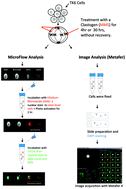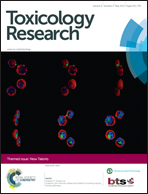New approaches to advance the use of genetic toxicology analyses for human health risk assessment†
Abstract
Genetic toxicology testing has a crucial role in the safety assessment of new and existing substances of societal value by reducing/eliminating human exposure to potential somatic and germ cell mutagens. Genetic toxicology assays have historically been used in a qualitative manner to arrive at the binary decision of ‘yes’ or ‘no’ with regards to the mutagenic potential. However, the field is currently at a crossroads, with new methods being developed and new proposals being made to use genetic toxicity data in a more quantitative manner. Technological advances have made it possible to perform high-content, high-throughput and high-precision analysis to increase the number of “scored” events leading to increased statistical precision of the endpoint under evaluation. Automated flow cytometry and image analysis are providing significant advantages for the evaluation of gene mutations as well as cytogenetic damage both in vitro and in vivo. In addition, statistical methods such as the benchmark dose (BMD) approach can be used to identify point of departure (PoD) metrics for use in human health risk assessments, including estimation of reference dose (RfD) and margins of exposure (MOE) from in vivo data. Here we provide new data to compare different in vitro micronucleus approaches, observing that the flow based assay performs very well in defining a PoD for methyl methanesulfonate. We also present reanalysis of published in vivo Pig-a gene mutation data, to show how covariate analysis increases precision and reduces the effects of outliers when defining BMD values. Furthermore, we show how in vivo BMD metrics can be used to define RfD values, and then provide comparisons to other human exposure limit values such as permitted daily exposure (PDE). Finally, the principles of empirical correlation using BMD metrics are presented, with methods for derivation of BMD values for endpoint B, when using data from only endpoint A. These developments are opening the possibility of genetic toxicity data being used as an apical endpoint to define negligible risk in human health risk assessments. Expert groups consisting of stakeholders representing academia, industry and the government are now developing guidance on transforming genetic toxicology testing from a qualitative to a quantitative science, keeping in mind the 3R principles of animal welfare.

- This article is part of the themed collection: New Talents

 Please wait while we load your content...
Please wait while we load your content...